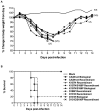Antibody pressure by a human monoclonal antibody targeting the 2009 pandemic H1N1 virus hemagglutinin drives the emergence of a virus with increased virulence in mice
- PMID: 22647789
- PMCID: PMC3372962
- DOI: 10.1128/mBio.00120-12
Antibody pressure by a human monoclonal antibody targeting the 2009 pandemic H1N1 virus hemagglutinin drives the emergence of a virus with increased virulence in mice
Abstract
In 2009, a novel H1N1 influenza A virus (2009 pH1N1) emerged and caused a pandemic. A human monoclonal antibody (hMAb; EM4C04), highly specific for the 2009 pH1N1 virus hemagglutinin (HA), was isolated from a severely ill 2009 pH1N1 virus-infected patient. We postulated that under immune pressure with EM4C04, the 2009 pH1N1 virus would undergo antigenic drift and mutate at sites that would identify the antibody binding site. To do so, we infected MDCK cells in the presence of EM4C04 and generated 11 escape mutants, displaying 7 distinct amino acid substitutions in the HA. Six substitutions greatly reduced MAb binding (K123N, D131E, K133T, G134S, K157N, and G158E). Residues 131, 133, and 134 are contiguous with residues 157 and 158 in the globular domain structure and contribute to a novel pH1N1 antibody epitope. One mutation near the receptor binding site, S186P, increased the binding affinity of the HA to the receptor. 186P and 131E are present in the highly virulent 1918 virus HA and were recently identified as virulence determinants in a mouse-passaged pH1N1 virus. We found that pH1N1 escape variants expressing these substitutions enhanced replication and lethality in mice compared to wild-type 2009 pH1N1 virus. The increased virulence of these viruses was associated with an increased affinity for α2,3 sialic acid receptors. Our study demonstrates that antibody pressure by an hMAb targeting a novel epitope in the Sa region of 2009 pH1N1 HA is able to inadvertently drive the development of a more virulent virus with altered receptor binding properties. This broadens our understanding of antigenic drift.
Importance: Influenza viruses accumulate amino acid substitutions to evade the antibody response in a process known as antigenic drift, making it necessary to vaccinate against influenza annually. Mapping human monoclonal antibody (hMAb) epitopes is a necessary step towards understanding antigenic drift in humans. We defined the specificity of an hMAb that specifically targeted the 2009 pH1N1 virus and describe a novel epitope. In addition, we identified a previously unappreciated potential for antibody escape to enhance the pathogenicity of a virus. The escape mutation that we identified with in vitro immune pressure was independently reported by other investigators using in vivo selection in nonimmune mice. Although in vitro generation of escape mutants is unlikely to recapitulate antigenic drift in its entirety, the data demonstrate that pressure by a human monoclonal antibody targeting a novel epitope in the hemagglutinin of the 2009 pandemic H1N1 virus can inadvertently drive the development of escape mutants, of which a subset have increased virulence and altered receptor binding properties.
Figures



Similar articles
-
Immune history shapes specificity of pandemic H1N1 influenza antibody responses.J Exp Med. 2013 Jul 29;210(8):1493-500. doi: 10.1084/jem.20130212. Epub 2013 Jul 15. J Exp Med. 2013. PMID: 23857983 Free PMC article.
-
Epitope mapping of the hemagglutinin molecule of A/(H1N1)pdm09 influenza virus by using monoclonal antibody escape mutants.J Virol. 2014 Nov;88(21):12364-73. doi: 10.1128/JVI.01381-14. Epub 2014 Aug 13. J Virol. 2014. PMID: 25122788 Free PMC article.
-
Epitope mapping of the 2009 pandemic and the A/Brisbane/59/2007 seasonal (H1N1) influenza virus haemagglutinins using mAbs and escape mutants.J Gen Virol. 2014 Nov;95(Pt 11):2377-2389. doi: 10.1099/vir.0.067819-0. Epub 2014 Jul 30. J Gen Virol. 2014. PMID: 25078301
-
The antigenic architecture of the hemagglutinin of influenza H5N1 viruses.Mol Immunol. 2013 Dec;56(4):705-19. doi: 10.1016/j.molimm.2013.07.010. Epub 2013 Aug 7. Mol Immunol. 2013. PMID: 23933511 Review.
-
N-linked glycosylation in the hemagglutinin of influenza A viruses.Yonsei Med J. 2012 Sep;53(5):886-93. doi: 10.3349/ymj.2012.53.5.886. Yonsei Med J. 2012. PMID: 22869469 Free PMC article. Review.
Cited by
-
Immune history shapes specificity of pandemic H1N1 influenza antibody responses.J Exp Med. 2013 Jul 29;210(8):1493-500. doi: 10.1084/jem.20130212. Epub 2013 Jul 15. J Exp Med. 2013. PMID: 23857983 Free PMC article.
-
The use of plant lectins to regulate H1N1 influenza A virus receptor binding activity.PLoS One. 2018 Apr 9;13(4):e0195525. doi: 10.1371/journal.pone.0195525. eCollection 2018. PLoS One. 2018. PMID: 29630683 Free PMC article.
-
Frequent Isolations of Influenza A Viruses (H1N1)pdm09 with Identical Hemagglutinin Sequences for More Than Three Months in Japan.Yonago Acta Med. 2015 Dec;58(4):165-71. Epub 2015 Dec 18. Yonago Acta Med. 2015. PMID: 26740735 Free PMC article.
-
Infectious Entry and Neutralization of Pathogenic JC Polyomaviruses.Cell Rep. 2017 Oct 31;21(5):1169-1179. doi: 10.1016/j.celrep.2017.10.027. Cell Rep. 2017. PMID: 29091757 Free PMC article.
-
IgG3 subclass antibodies recognize antigenically drifted influenza viruses and SARS-CoV-2 variants through efficient bivalent binding.bioRxiv [Preprint]. 2022 Sep 28:2022.09.27.509738. doi: 10.1101/2022.09.27.509738. bioRxiv. 2022. Update in: Proc Natl Acad Sci U S A. 2023 Aug 29;120(35):e2216521120. doi: 10.1073/pnas.2216521120. PMID: 36203556 Free PMC article. Updated. Preprint.
References
-
- Wright PF, Neumann G, Kawaoka Y. 2007. Orthomyxoviruses, p 1691–1740 In Knipe DM, Fields virology, 5th ed. Lippincott Williams & Wilkins, Philadelphia, PA.
-
- Couch RB, Kasel JA. 1983. Immunity to influenza in man. Annu. Rev. Microbiol. 37:529–549 - PubMed
-
- Potter CW, Oxford JS. 1979. Determinants of immunity to influenza infection in man. Br. Med. Bull. 35:69–75 - PubMed
-
- Epstein SL, et al. 1993. Beta 2-microglobulin-deficient mice can be protected against influenza A infection by vaccination with vaccinia-influenza recombinants expressing hemagglutinin and neuraminidase. J. Immunol. 150:5484–5493 - PubMed
-
- Martinez O, Tsibane T, Basler CF. 2009. Neutralizing anti-influenza virus monoclonal antibodies: therapeutics and tools for discovery. Int. Rev. Immunol. 28:69–92 - PubMed
Publication types
MeSH terms
Substances
Grants and funding
LinkOut - more resources
Full Text Sources
Other Literature Sources
Medical

